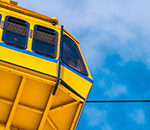A cylinder is a sphere and cube combined. When lighted, a cylinder has a highlight side, an incident highlight, a core shadow and shape shadow. The light can either go around the cylinder for more or less highlight, or it can go up and down to change the darkness on top. Jay P Morgan created this video to demonstrate how light affects shape and how you can use the laws of light to improve your photography:
The cast shadow on a tall object such as a cylinder decreases in size as the light is positioned higher above it. However, it brightens the top surface of the cylinder. In order to avoid the harsh brightness, for example, Jay P. Morgan uses diffusion to hit the top of it and decrease the light. The light behind the object creates the separation between the cylinder’s bright and dark sides. The cylinder starts to lose its edge with harsh light, so a fill card can be used to bring that shadow back onto the dark side. This helps create the 3D look for your cylinder.
Learning to combine surfaces allows you to photograph objects such as shapes and faces together. You learn to position your lighting for both of them instead of trying to get them to work together as individuals. Hopefully, you learned some great tricks from this video to use for arranging your composition and lighting with different objects!
“You need to understand transitional objects and how they relate to actual objects in life, because very few things in life are a sphere or a square.”
For further training: using a cube to understand photography lighting
Like This Article?
Don't Miss The Next One!
Join over 100,000 photographers of all experience levels who receive our free photography tips and articles to stay current:







Leave a Reply